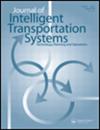捕捉真正的边界框:利用无人飞行器提取车辆运动学数据
IF 2.8
3区 工程技术
Q3 TRANSPORTATION
Journal of Intelligent Transportation Systems
Pub Date : 2025-09-03
DOI:10.1080/15472450.2024.2341395
引用次数: 0
摘要
本文介绍了一种从无人驾驶飞行器(UAV)镜头中提取道路车辆运动学变量的方法。车辆的定向边界框是通过识别车辆的运动变量来确定的。本文章由计算机程序翻译,如有差异,请以英文原文为准。
Capturing the true bounding boxes: vehicle kinematic data extraction using unmanned aerial vehicles
This paper presents a methodology by which kinematic variables of road vehicles can be extracted from unmanned aerial vehicle (UAV) footage. The oriented bounding boxes of the vehicles are identified based on the aerial view of the intersection, and the kinematic variables, such as position, longitudinal velocity, lateral velocity, yaw angle and yaw rate, are determined. The bounding boxes are converted to the perspective of a roadside camera using homography, to generate labeled data sets for training the machine learning-based perception systems of smart intersections. Compared to ordinary GPS data-based technology, the proposed method provides smoother data and more information about the dynamics of the vehicles. In the meantime, it does not require any additional instrumentation on the vehicles. The extracted kinematic variables can be used for motion prediction of road traffic participants and for control of connected automated vehicles (CAVs) in intelligent transportation systems.
求助全文
通过发布文献求助,成功后即可免费获取论文全文。
去求助
来源期刊
CiteScore
8.80
自引率
19.40%
发文量
51
审稿时长
15 months
期刊介绍:
The Journal of Intelligent Transportation Systems is devoted to scholarly research on the development, planning, management, operation and evaluation of intelligent transportation systems. Intelligent transportation systems are innovative solutions that address contemporary transportation problems. They are characterized by information, dynamic feedback and automation that allow people and goods to move efficiently. They encompass the full scope of information technologies used in transportation, including control, computation and communication, as well as the algorithms, databases, models and human interfaces. The emergence of these technologies as a new pathway for transportation is relatively new.
The Journal of Intelligent Transportation Systems is especially interested in research that leads to improved planning and operation of the transportation system through the application of new technologies. The journal is particularly interested in research that adds to the scientific understanding of the impacts that intelligent transportation systems can have on accessibility, congestion, pollution, safety, security, noise, and energy and resource consumption.
The journal is inter-disciplinary, and accepts work from fields of engineering, economics, planning, policy, business and management, as well as any other disciplines that contribute to the scientific understanding of intelligent transportation systems. The journal is also multi-modal, and accepts work on intelligent transportation for all forms of ground, air and water transportation. Example topics include the role of information systems in transportation, traffic flow and control, vehicle control, routing and scheduling, traveler response to dynamic information, planning for ITS innovations, evaluations of ITS field operational tests, ITS deployment experiences, automated highway systems, vehicle control systems, diffusion of ITS, and tools/software for analysis of ITS.

 求助内容:
求助内容: 应助结果提醒方式:
应助结果提醒方式:


